Characterization of Aerosol Pollution in Two Hungarian Cities in Winter 2009–2010
Abstract
:1. Introduction
2. Materials and Methods
2.1. General Description of the Sampling Sites
2.2. Aerosol Sampling
2.3. Elemental Analysis
2.4. Source Apportionment by PMF
- (1)
- If the concentration of the chemical species is less than or equal to the MDL provided:
- (2)
- If the concentration is greater than the MDL provided:where C is the concentration of the chemical species, MDL is the method specific detection limit, and ’error fraction’ is the estimated measurement uncertainty of the given species.
3. Results
3.1. Mass Concentration
3.2. Elemental Concentration
3.3. Sources of Urban Aerosol Pollution
3.4. Comparison with Data from 2015
4. Summary and Conclusions
Supplementary Materials
Author Contributions
Funding
Institutional Review Board Statement
Data Availability Statement
Conflicts of Interest
References
- UN; Department of Economic and Social Affairs, Population Division. The World’s Cities in 2018—Data Booklet; ST/ESA/SER.A/417; UN: New York, NY, USA, 2018. [Google Scholar]
- Cohen, A.J.; Anderson, H.R.; Ostro, B.; Pandey, K.D.; Krzyzanowski, M.; Kunzli, N.; Gutschmidt, K.; Pope, A.; Romieu, I.; Samet, J.M.; et al. The global burden of disease due to outdoor air pollution. J. Toxicol. Environ. Health Part A-Curr. Issues 2005, 68, 1301–1307. [Google Scholar] [CrossRef] [PubMed]
- Paraskevopoulou, D.; Liakakou, E.; Gerasopoulos, E.; Mihalopoulos, N. Sources of atmospheric aerosol from long-term measurements (5 years) of chemical composition in Athens, Greece. Sci. Total Environ. 2015, 527, 165–178. [Google Scholar] [CrossRef] [PubMed]
- Cesari, D.; Donateo, A.; Conte, M.; Merico, E.; Giangreco, A.; Giangreco, F.; Contini, D. An inter-comparison of PM2.5 at urban and urban background sites: Chemical characterization and source apportionment. Atmos. Res. 2016, 174, 106–119. [Google Scholar] [CrossRef]
- Khain, A.; Lynn, B.; Shpund, J. High resolution WRF simulations of Hurricane Irene: Sensitivity to aerosols and choice of microphysical schemes. Atmos. Res. 2016, 167, 129–145. [Google Scholar] [CrossRef] [Green Version]
- Zhao, H.J.; Che, H.Z.; Ma, Y.J.; Xia, X.G.; Wang, Y.F.; Wang, P.; Wu, X.C. Temporal variability of the visibility, particulate matter mass concentration and aerosol optical properties over an urban site in Northeast China. Atmos. Res. 2015, 166, 204–212. [Google Scholar] [CrossRef]
- IPCC. Climate Change 2014: Impacts, Adaptation, and Vulnerability; AnnexII. Glossary; Field, C.B., Barros, V.R., Dokken, D.J., Mach, K.J., Mastrandrea, M.D., Bilir, T.E., Chatterjee, M., Ebi, K.L., Estrada, Y.O., Genova, R.C., et al., Eds.; Cambridge University Press: Cambridge, UK; New York, NY, USA, 2014; p. 1763. Available online: http://www.ipcc.ch/report/ar5/wg2/ (accessed on 24 March 2022).
- Amann, M.; Bertok, I.; Cofala, J.; Gyarfas, F.; Heyes, C.; Klimont, Z.; Schöpp, W.; Winiwarter, W. Baseline Scenarios for the Clean Air for Europe (CAFE) Programme. Available online: https://ec.europa.eu/environment/archives/cafe/activities/pdf/cafe_scenario_report_1.pdf (accessed on 24 March 2022).
- Pope, C.A.; Burnett, R.T.; Thun, M.J.; Calle, E.E.; Krewski, D.; Ito, K.; Thurston, G.D. Lung cancer, cardiopulmonary mortality, and long-term exposure to fine particulate air pollution. JAMA-J. Am. Med. Assoc. 2002, 287, 1132–1141. [Google Scholar] [CrossRef] [Green Version]
- Martins, V.; Minguillon, M.C.; Moreno, T.; Querol, X.; de Miguel, E.; Capdevila, M.; Centelles, S.; Lazaridis, M. Deposition of aerosol particles from a subway microenvironment in the human respiratory tract. J. Aerosol Sci. 2015, 90, 103–113. [Google Scholar] [CrossRef] [Green Version]
- Nel, A. Air pollution-related illness: Effects of particles. Science 2005, 309, 1326. [Google Scholar] [CrossRef]
- Monn, C. Exposure assessment of air pollutants: A review on spatial heterogeneity and indoor/outdoor/personal exposure to suspended particulate matter, nitrogen dioxide and ozone. Atmos. Environ. 2001, 35, 1–32. [Google Scholar] [CrossRef]
- Putaud, J.P.; Van Dingenen, R.; Alastuey, A.; Bauer, H.; Birmili, W.; Cyrys, J.; Flentje, H.; Fuzzi, S.; Gehrig, R.; Hansson, H.C.; et al. A European aerosol phenomenology-3: Physical and chemical characteristics of particulate matter from 60 rural, urban, and kerbside sites across Europe. Atmos. Environ. 2010, 44, 1308–1320. [Google Scholar] [CrossRef]
- Amato, F.; Alastuey, A.; Karanasiou, A.; Lucarelli, F.; Nava, S.; Calzolai, G.; Severi, M.; Becagli, S.; Gianelle, V.L.; Colombi, C.; et al. AIRUSE-LIFE+: A harmonized PM speciation and source apportionment in 5 Southern European Cities. Atmos. Chem. Phys. Discuss. 2016, 15, 23989–24039. [Google Scholar] [CrossRef] [Green Version]
- Costa, V.; Bacco, D.; Castellazzi, S.; Ricciardelli, I.; Vecchietti, R.; Zigola, C.; Pietrogrande, M.C. Characteristics of carbonaceous aerosols in Emilia-Romagna (Northern Italy) based on two fall/winter field campaigns. Atmos. Res. 2016, 167, 100–107. [Google Scholar] [CrossRef]
- Pauraite, J.; Mordas, G.; Bycenkiene, S.; Ulevicius, V. Spatial and Temporal Analysis of Organic and Black Carbon Mass Concentrations in Lithuania. Atmosphere 2015, 6, 1229–1242. [Google Scholar] [CrossRef] [Green Version]
- Vodicka, P.; Schwarz, J.; Cusack, M.; Zdimal, V. Detailed comparison of OC/EC aerosol at an urban and a rural Czech background site during summer and winter. Sci. Total Environ. 2015, 518, 424–433. [Google Scholar] [CrossRef] [PubMed]
- Avino, P.; Manigrasso, M.; Rosada, A.; Dodaro, A. Measurement of organic and elemental carbon in downtown Rome and background area: Physical behavior and chemical speciation. Environ. Sci.-Process. Impacts 2015, 17, 300–315. [Google Scholar] [CrossRef]
- Heal, M.R.; Hammonds, M.D. Insights into the Composition and Sources of Rural, Urban and Roadside Carbonaceous PM10. Environ. Sci. Technol. 2014, 48, 8995–9003. [Google Scholar] [CrossRef]
- Dall’Osto, M.; Querol, X.; Amato, F.; Karanasiou, A.; Lucarelli, F.; Nava, S.; Calzolai, G.; Chiari, M. Hourly elemental concentrations in PM2.5 aerosols sampled simultaneously at urban background and road site during SAPUSS-diurnal variations and PMF receptor modelling. Atmos. Chem. Phys. 2013, 13, 4375–4392. [Google Scholar] [CrossRef] [Green Version]
- Gianini, M.F.D.; Piot, C.; Herich, H.; Besombes, J.L.; Jaffrezo, J.L.; Hueglin, C. Source apportionment of PM10, organic carbon and elemental carbon at Swiss sites: An intercomparison of different approaches. Sci. Total Environ. 2013, 454, 99–108. [Google Scholar] [CrossRef]
- Beuck, H.; Quass, U.; Klemm, O.; Kuhlbusch, T.A.J. Assessment of sea salt and mineral dust contributions to PM10 in NW Germany using tracer models and positive matrix factorization. Atmos. Environ. 2011, 45, 5813–5821. [Google Scholar] [CrossRef]
- Arruti, A.; Fernandez-Olmo, I.; Irabien, A. Regional evaluation of particulate matter composition in an Atlantic coastal area (Cantabria region, northern Spain): Spatial variations in different urban and rural environments. Atmos. Res. 2011, 101, 280–293. [Google Scholar] [CrossRef]
- Van Dingenen, R.; Raes, F.; Putaud, J.P.; Baltensperger, U.; Charron, A.; Facchini, M.C.; Decesari, S.; Fuzzi, S.; Gehrig, R.; Hansson, H.C.; et al. A European aerosol phenomenology-1: Physical characteristics of particulate matter at kerbside, urban, rural and background sites in Europe. Atmos. Environ. 2004, 38, 2561–2577. [Google Scholar] [CrossRef]
- Querol, X.; Alastuey, A.; Ruiz, C.R.; Artinano, B.; Hansson, H.C.; Harrison, R.M.; Buringh, E.; ten Brink, H.M.; Lutz, M.; Bruckmann, P.; et al. Speciation and origin of PM10 and PM2.5 in selected European cities. Atmos. Environ. 2004, 38, 6547–6555. [Google Scholar] [CrossRef]
- Juda-Rezler, K. Assessing the winter time air pollution in Cracow (Poland) in relation with possible influences on human health and cultural heritage. Pol. J. Environ. Stud. 2006, 15, 123–128. [Google Scholar]
- Houthuijs, D.; Breugelmans, O.; Hoek, G.; Vaskovi, E.; Mihalikova, E.; Pastuszka, J.S.; Jirik, V.; Sachelarescu, S.; Lolova, D.; Meliefste, K.; et al. PM10 and PM2.5 concentrations in Central and Eastern Europe: Results from the Cesar study. Atmos. Environ. 2001, 35, 2757–2771. [Google Scholar] [CrossRef]
- Kukkonen, J.; Pohjola, M.; Sokhi, R.S.; Luhana, L.; Kitwiroon, N.; Fragkou, L.; Rantamäki, M.; Berge, E.; Ødegaard, V.; Slørdal, L.H.; et al. Analysis and evaluation of selected local-scale PM10 air pollution episodes in four European cities: Helsinki, London, Milan and Oslo. Atmos. Environ. 2005, 39, 2759–2773. [Google Scholar] [CrossRef]
- Wilczyńska-Michalik, W.; Różańska, A.; Bulanda, M.; Chmielarczyk, A.; Pietras, B.; Michalik, M. Physicochemical and microbiological characteristics of urban aerosols in Krakow (Poland) and their potential health impact. Environ. Geochem. Health 2021, 43, 4601–4626. [Google Scholar] [CrossRef]
- Zimnoch, M.; Morawski, F.; Kuc, T.; Samek, L.; Bartyzel, J.; Gorczyca, Z.; Skiba, A.; Rozanski, K. Summer–winter contrast in carbon isotope and elemental composition of total suspended particulate matter in the urban atmosphere of Krakow, Southern Poland. Nukleonika 2020, 65, 181–191. [Google Scholar] [CrossRef]
- Błaszczak, B.; Widziewicz-Rzońca, K.; Zioła, N.; Klejnowski, K.; Juda-Rezler, K. Chemical characteristics of fine particulate matter in Poland in relation with data from selected rural and urban background stations in Europe. Appl. Sci. 2019, 9, 98. [Google Scholar] [CrossRef] [Green Version]
- Vossler, T.; Cernikovsky, L.; Novak, J.; Placha, H.; Krejci, B.; Nikolova, I.; Chalupnickova, E.; Williams, R. An investigation of local and regional sources of fine particulate matter in Ostrava, the Czech Republic. Atmos. Pollut. Res. 2015, 6, 454–463. [Google Scholar]
- Vossler, T.; Černikovský, L.; Novák, J.; Williams, R. Source apportionment with uncertainty estimates of fine particulate matter in Ostrava, Czech Republic using Positive Matrix Factorization. Atmos. Pollut. Res. 2016, 7, 503–512. [Google Scholar] [CrossRef]
- Jandacka, D.; Durcanska, D. Differentiation of particulate matter sources based on the chemical composition of PM10 in functional urban areas. Atmosphere 2019, 10, 583. [Google Scholar] [CrossRef] [Green Version]
- Alina, N.; Bogdan, N.; Dumitru, M. Evaluation of Air Pollution by Particulate Matter PM10 in the NE Region of Romania. Available online: http://georeview.ro/ojs/index.php/revista/article/view/432 (accessed on 24 March 2022).
- Proorocu, M.; Odagiu, A.; Oroian, I.G.; Ciuiu, G.; Dan, V. Particulate matter status in romanian urban areas: PM10 pollution levels in bucharest. Environ. Eng. Manag. J. 2014, 13, 3115–3122. [Google Scholar] [CrossRef]
- Jeričević, A.; Grgičin, V.D.; Prtenjak, M.T.; Vidič, S.; Bloemen, H. Analyses of urban and rural particulate matter mass concentrations in Croatia in the period 2006–2014. Geofizika 2016, 33, 157–181. [Google Scholar] [CrossRef]
- Habulan, M.; Đurin, B.; Siročić, A.P.; Sakač, N. Analysis of the Particulate Matter Pollution in the Urban Areas of Croatia, EU. Environ. Sci. Proc. 2021, 4, 9. [Google Scholar] [CrossRef]
- Perrone, M.G.; Vratolis, S.; Georgieva, E.; Török, S.; Šega, K.; Veleva, B.; Osán, J.; Bešlić, I.; Kertész, Z.; Pernigotti, D.; et al. Sources and geographic origin of particulate matter in urban areas of the Danube macro-region: The cases of Zagreb (Croatia), Budapest (Hungary) and Sofia (Bulgaria). Sci. Total Environ. 2018, 619, 1515–1529. [Google Scholar] [CrossRef]
- Almeida, S.M.; Manousakas, M.; Diapouli, E.; Kertesz, Z.; Samek, L.; Hristova, E.; Šega, K.; Alvarez, R.P.; Belis, C.A.; Eleftheriadis, K.; et al. Ambient particulate matter source apportionment using receptor modelling in European and Central Asia urban areas. Environ. Pollut. 2020, 266, 115–199. [Google Scholar] [CrossRef]
- Salma, I.; Maenhaut, W.; Zemplén-Papp, É.; Záray, G. Comprehensive characterisation of atmospheric aerosols in Budapest, Hungary: Physicochemical properties of inorganic species. Atmos. Environ. 2001, 35, 4367–4378. [Google Scholar] [CrossRef]
- Ferenczi, Z.; Imre, K.; Lakatos, M.; Molnár, Á.; Bozó, L.; Homolya, E.; Gelencsér, A. Long-term Characterization of Urban PM10 in Hungary. Aerosol Air Qual. Res. 2021, 21, 210048. [Google Scholar] [CrossRef]
- Czömpöly, O.; Börcsök, E.; Groma, V.; Pollastri, S.; Osán, J. Characterization of unique aerosol pollution episodes in urban areas using TXRF and TXRF-XANES. Atmos. Pollut. Res. 2021, 12, 101214. [Google Scholar] [CrossRef]
- Ferenczi, Z.; Bozó, L. Effect of the long-range transport on the air quality of greater Budapest area. Int. J. Environ. Pollut. 2017, 62, 407–416. [Google Scholar] [CrossRef]
- Angyal, F.Z.; Manousakas, M.; Furu, E.; Szoboszlai, Z.; Török, Z.; Papp, E.; Szikszai, Z.; Kertész, Z. Source identification of fine and coarse aerosol during smog episodes in Debrecen, Hungary. Air Qual. Atmos. Health 2021, 14, 1017–1032. [Google Scholar] [CrossRef]
- KözpontiStatisztikai Hivatal (KSH). Magyarország Közigazgatási Helynévkönyve 2013. 2013. Available online: https://www.ksh.hu/docs/hun/hnk/hnk_2013.pdf (accessed on 24 March 2022).
- Kft., C. Földrajzi Atlasz a 10–16 éves Tanulók Számára. 2005, pp. 7–17. Available online: https://utikonyv.eu/spd/k_739386/Foldrajzi-atlasz-a-10-16-eves-tanulok-szamara-CR-0 (accessed on 24 March 2022).
- Maenhaut, W.; Francois, F.; Cafmeyer, J. The “Gent” Stacked Filter Unit (SFU) Sampler for the Collection of Atmospheric Aerosols in Two Size Fractions: Description and Intrsuctions for Installation and Use; IAEA-NAHRES-19; IAEA: Vienna, Austria, 1994; pp. 249–263. [Google Scholar]
- Maenhaut, W.; Malmqvist, K.G. Particle–induced X-ray emission analysis. In Handbook of X-ray Spectrometry, 2nd ed.; Van Grieken, R.E., Ed.; Marcel Dekker: New York, NY, USA, 2001. [Google Scholar]
- Angyal, A.; Kertesz, Z.; Szikszai, Z.; Szoboszlai, Z.; Furu, E.; Csedreki, L.; Daroczi, L. Study of emission episodes of urban aerosols by ion beam analytical techniques. Nucl. Instrum. Methods Phys. Res. Sect. B-Beam Interact. Mater. At. 2011, 269, 2399–2403. [Google Scholar] [CrossRef]
- Papp, E.; Nagy, D.; Szoboszlai, Z.; Angyal, A.; Török, Z.; Csepregi, Á.; Furu, E.; Kertesz, Z. Investigation of aerosol pollution inside trams in Debrecen, Hungary. Nucl. Instrum. Methods Phys. Res. Sect. B-Beam Interact. Mater. At. 2020, 477, 138–143. [Google Scholar] [CrossRef]
- Furu, E.; Katona-Szabó, I.; Angyal, A.; Szoboszlai, Z.; Török, Z.; Kertész, Z. The effect of the tramway track construction on the aerosol pollution in Debrecen, Hungary. Nucl. Instrum. Methods Phys. Res. Sect. B-Beam Interact. Mater. At. 2015, 363, 124–130. [Google Scholar] [CrossRef] [Green Version]
- Borbelykiss, I.; Koltay, E.; Laszlo, S.; Szabo, G.; Zolnai, L. Experimental and Theoretical Calibration of a Pixe Setup for K and L X-Rays. Nucl. Instrum. Methods Phys. Res. Sect. B-Beam Interact. Mater. At. 1985, 12, 496–504. [Google Scholar] [CrossRef]
- Szabo, G.; Borbelykiss, I. Pixyklm Computer Package for Pixe Analyses. Nucl. Instrum. Methods Phys. Res. Sect. B-Beam Interact. Mater. At. 1993, 75, 123–126. [Google Scholar] [CrossRef]
- Szabó, G. PIXEKLM Program, User Guide; ATOMKI: Debrecen, Hungary, 2009. [Google Scholar]
- Adams, H.S.; Nieuwenhuijsen, M.J.; Colvile, R.N.; Older, M.J.; Kendall, M. Assessment of road users’ elemental carbon personal exposure levels, London, UK. Atmos. Environ. 2002, 36, 5335–5342. [Google Scholar] [CrossRef]
- Paatero, P.; Tapper, U. Positive matrix factorization: A non-negative factor model with optimal utilization of error estimates of data values. Environmetrics 1994, 5, 111–126. [Google Scholar] [CrossRef]
- Hopke, P.K. Review of receptor modeling methods for source apportionment. J. Air Waste Manag. Assoc. 2016, 66, 237–259. [Google Scholar] [CrossRef]
- Paatero, P. Least squares formulation of robust non-negative factor analysis. Chemom. Intell. Lab. Syst. 1997, 37, 23–35. [Google Scholar] [CrossRef]
- Kim, E.; Hopke, P.K.; Edgerton, E.S. Source identification of atlanta aerosol by positive matrix factorization. J. Air Waste Manag. Assoc. 2003, 53, 731–739. [Google Scholar] [CrossRef] [PubMed] [Green Version]
- Masiol, M.; Squizzato, S.; Formenton, G.; Khan, B.; Hopke, P.; Nenes, A.; Pandis, S.N.; Tositti, L.; Benetello, F.; Visin, F.; et al. Hybrid multiple-site mass closure and source apportionment of PM2.5 and aerosol acidity at major cities in the Po Valley. Sci. Total Environ. 2020, 704, 135–287. [Google Scholar] [CrossRef] [PubMed]
- Brown, S.G.; Eberly, S.; Paatero, P.; Norris, G.A. Methods for estimating uncertainty in PMF solutions: Examples with ambient air and water quality data and guidance on reporting PMF results. Sci. Total Environ. 2015, 518, 626–635. [Google Scholar] [CrossRef] [PubMed] [Green Version]
- WHO. WHO Global Air Quality Guidelines: Particulate Matter (PM2.5 and PM10), Ozone, Nitrogen. Dioxide, Sulfur Dioxide and Carbon Monoxide: Executive Summary; Licence: CC BY-NC-SA 3.0 IGO; World Health Organization: Geneva, Switzerland, 2021. [Google Scholar]
- EU. Standards-Air Quality-Environmnet-European Commission. 2008. Available online: https://ec.europa.eu/environment/air/quality/standards.htm (accessed on 24 March 2022).
- World Health Organization; Occupational and Environmental Health Team. WHO Air Quality Guidelines for Particulate Matter, Ozone, Nitrogen Dioxide and Sulfur Dioxide: Global Update 2005: Summary of Risk Assessment. 2006. Available online: https://apps.who.int/iris/handle/10665/69477 (accessed on 24 March 2022).
- Cohen, D.D.; Atanacio, A.; Crawford, J.; Siegele, R. Ion beam techniques for source fingerprinting fine particle air pollution in major Asian-Pacific cities. Nucl. Instrum. Methods Phys. Res. Sect. B Beam Interact. Mater. At. 2020, 477, 122–132. [Google Scholar] [CrossRef]
- Mónok, D.; Kardos, L.; Pabar, S.A.; Kotroczó, Z.; Tóth, E.; Végvári, G. Comparison of soil properties in urban and non-urban grasslands in Budapest area. Soc. Soil Sci. 2020, 37, 790–801. [Google Scholar] [CrossRef]
- Borbely-Kiss, I.; Kertesz, Z.; Koltay, E.; Szabo, G.; Tar, K. Composition of urban and rural aerosol samples collected in the Great Hungarian Plain. Nucl. Instrum. Methods Phys. Res. Sect. B-Beam Interact. Mater. At. 1999, 150, 339–344. [Google Scholar] [CrossRef]
- Kertész, Z.; Szoboszlai, Z.; Angyal, A.; Dobos, E.; Borbély-Kiss, I. Identification and characterization of fine and coarse particulate matter sources in a middle-European urban environment. Nucl. Instrum. Methods Phys. Res. B 2010, 268, 1924–1928. [Google Scholar] [CrossRef]
- Yu, J.T.; Yan, C.Q.; Liu, Y.; Li, X.Y.; Zhou, T.; Zheng, M. Potassium: A Tracer for Biomass Burning in Beijing? Aerosol Air Qual. Res. 2018, 18, 2447–2459. [Google Scholar] [CrossRef] [Green Version]
- Zhang, R.; Jing, J.; Tao, J.; Hsu, S.C.; Wang, G.; Cao, J.; Lee, C.S.L.; Zhu, L.; Chen, Z.; Zhao, Y.; et al. Chemical characterization and source apportionment of PM2.5 in Beijing: Seasonal perspective. Atmos. Chem. Phys. 2013, 13, 7053–7074. [Google Scholar] [CrossRef] [Green Version]
- Zhang, Y.S.; Shao, M.; Lin, Y.; Luan, S.J.; Mao, N.; Chen, W.T.; Wang, M. Emission inventory of carbonaceous pollutants from biomass burning in the Pearl River Delta Region, China. Atmos. Environ. 2013, 76, 189–199. [Google Scholar] [CrossRef]
- Tao, J.; Gao, J.; Zhang, L.; Zhang, R.; Che, H.; Zhang, Z.; Lin, Z.; Jing, J.; Cao, J.; Hsu, S.C. PM2.5 pollution in a megacity of southwest China: Source apportionment and implication. Atmos. Chem. Phys. 2014, 14, 8679–8699. [Google Scholar] [CrossRef] [Green Version]
- McNamara, S.M.; Kolesar, K.R.; Wang, S.; Kirpes, R.M.; May, N.W.; Gunsch, M.J.; Cook, R.D.; Fuentes, J.D.; Hornbrook, R.S.; Apel, E.C.; et al. Observation of Road Salt Aerosol Driving Inland Wintertime Atmospheric Chlorine Chemistry. ACS Cent. Sci. 2020, 6, 684–694. [Google Scholar] [CrossRef] [PubMed]
- Katheryn, K.R.; Mattson, C.N.; Peterson, P.K.; May, N.W.; Prendergast, R.K.; Pratt, K.A. Increases in wintertime PM2.5 sodium and chloride linked to snowfall and road salt application. Atmos. Environ. 2018, 177, 195–202. [Google Scholar]
- Kertesz, Z.; Furu, E.; Kavcic, M. Chemical speciation of chlorine in atmospheric aerosol samples by high-resolution proton induced X-ray emission spectroscopy. Spectrochim. Acta Part B-At. Spectrosc. 2013, 79–80, 58–62. [Google Scholar] [CrossRef]
- Gunawardana, C.; Goonetilleke, A.; Egodawatta, P.; Dawes, L.; Kokot, S. Source characterisation of road dust based on chemical and mineralogical composition. Chemosphere 2012, 87, 163–170. [Google Scholar] [CrossRef] [Green Version]
- Kertész, Z.; Szoboszlai, Z.; Dobos, E.; Borbélyné-Kiss, I. Characterization of urban aerosol sources in Debrecen, Hungary. AGD Landsc. Environ. 2008, 2, 109–119. [Google Scholar]
- Viana, M.; Kuhlbusch, T.A.J.; Querol, X.; Alastuey, A.; Harrison, R.M.; Hopke, P.K.; Winiwarter, W.; Vallius, A.; Szidat, S.; Prevot, A.S.H.; et al. Source apportionment of particulate matter in Europe: A review of methods and results. J. Aerosol Sci. 2008, 39, 827–849. [Google Scholar] [CrossRef]
- Wang, L.; Qi, J.H.; Shi, J.H.; Chen, X.J.; Gao, H.W. Source apportionment of particulate pollutants in the atmosphere over the Northern Yellow Sea. Atmos. Environ. 2013, 70, 425–434. [Google Scholar] [CrossRef]
- Hjortenkrans, D. Road Traffic Metals–Sources and Emissions. Ph.D. Thesis, Faculty of Natural Sciences and Engineering, University of Kalmar, Kalmar, Sweden, 2008. [Google Scholar]
- Kar, S.; Maity, J.P.; Samal, A.C.; Santra, S.C. Metallic components of traffic-induced urban aerosol, their spatial variation, and source apportionment. Environ. Monit. Assess. 2010, 168, 561–574. [Google Scholar] [CrossRef]
- Christoforidis, A.; Stamatis, N. Heavy metal contamination in street dust and roadside soil along the major national road in Kavala’s region, Greece. Geoderma 2009, 151, 257–263. [Google Scholar] [CrossRef]
- Angyal, A.; Kertesz, Z.; Szikszai, Z.; Szoboszlai, Z. Study of Cl-containing urban aerosol particles by ion beam analytical methods. Nucl. Instrum. Methods Phys. Res. Sect. B-Beam Interact. Mater. At. 2010, 268, 2211–2215. [Google Scholar] [CrossRef]


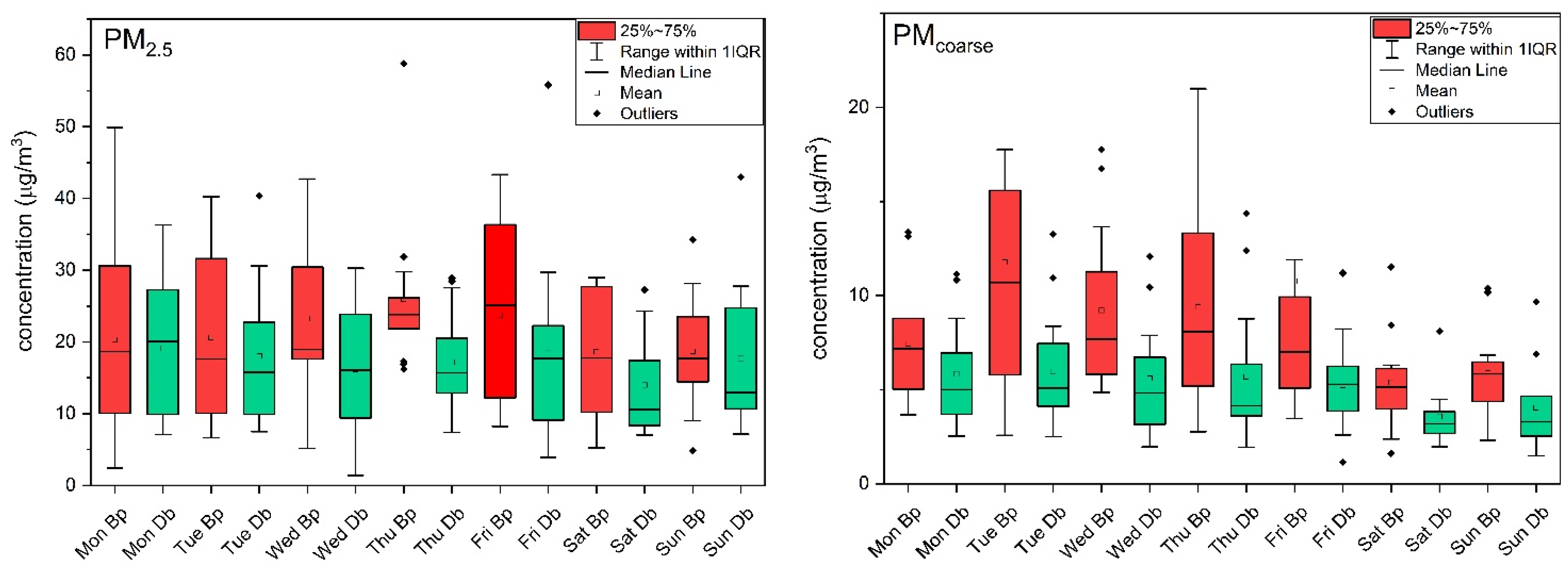
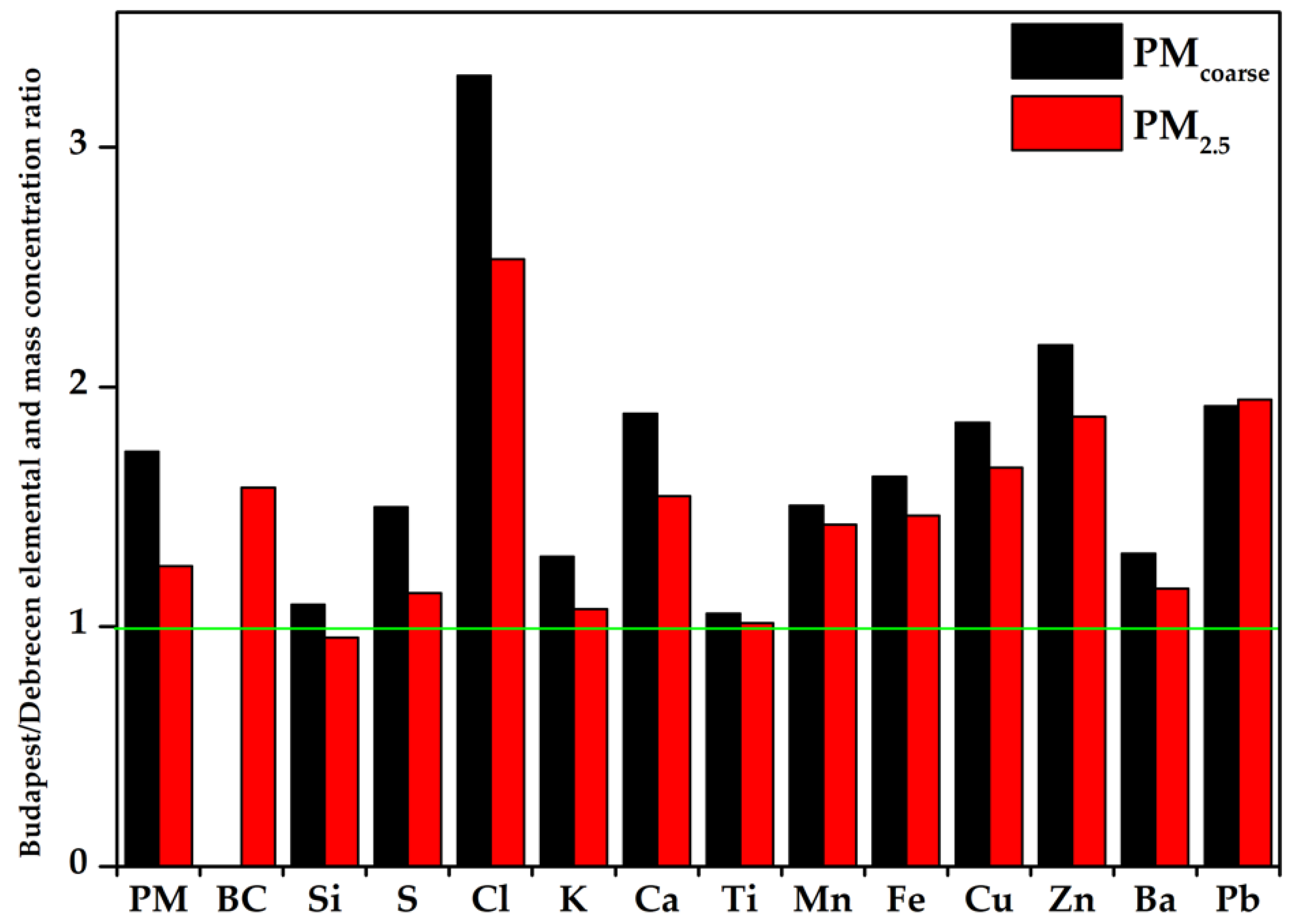


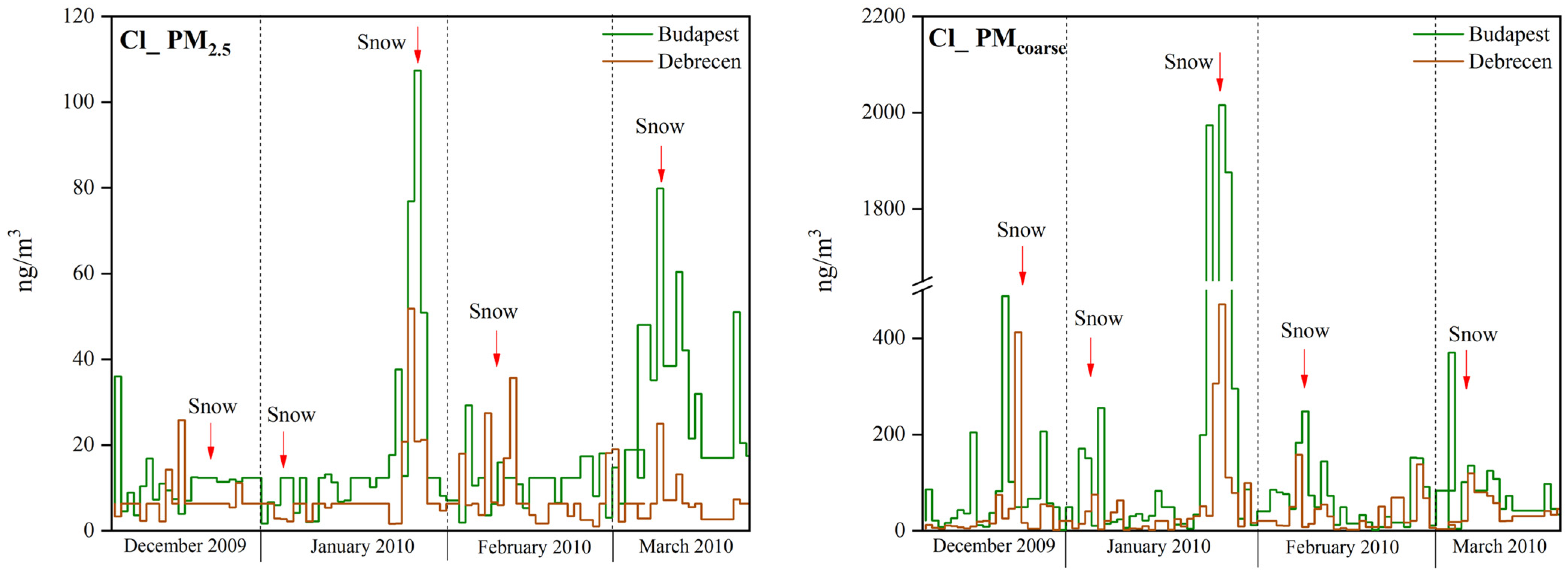
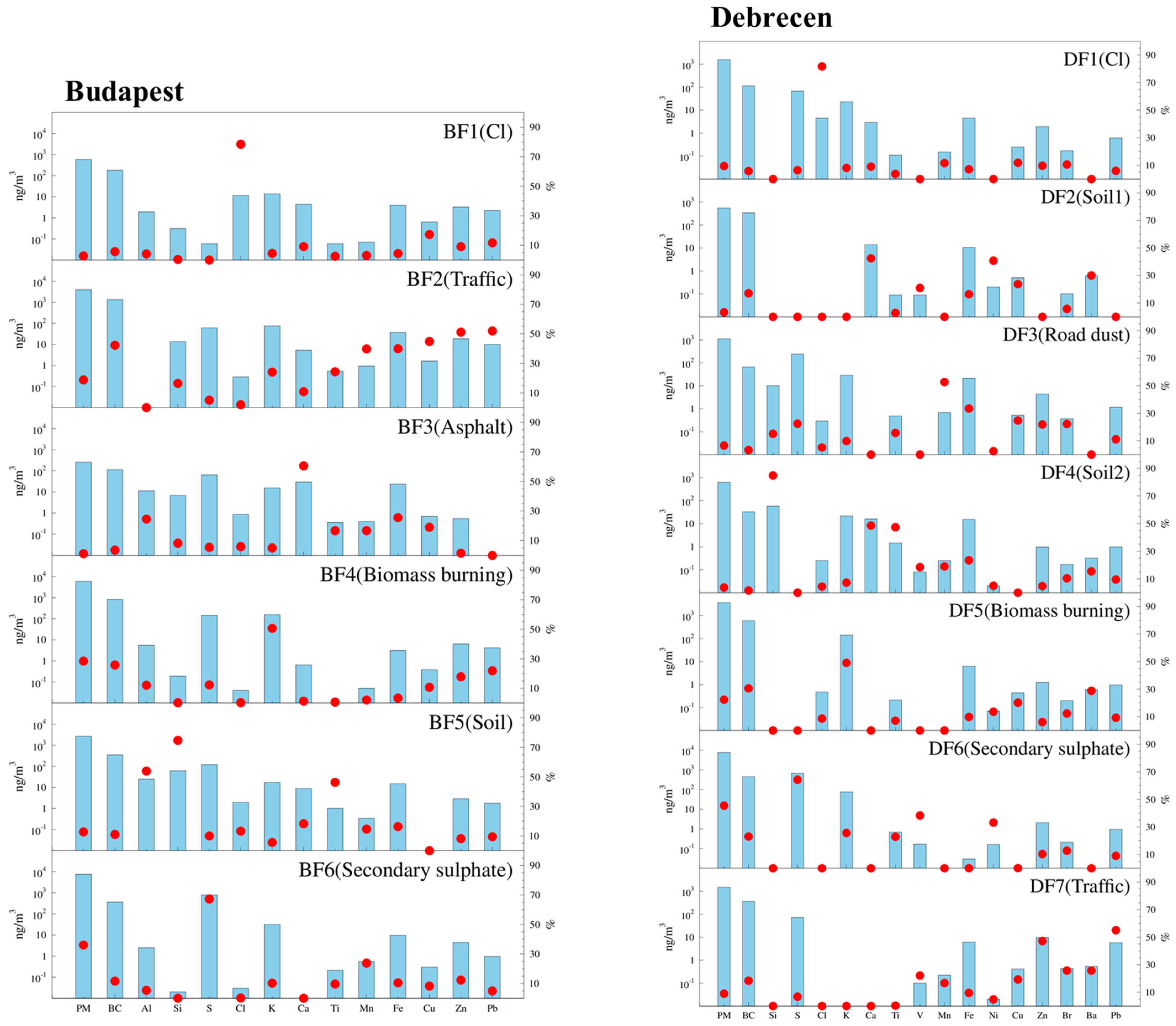
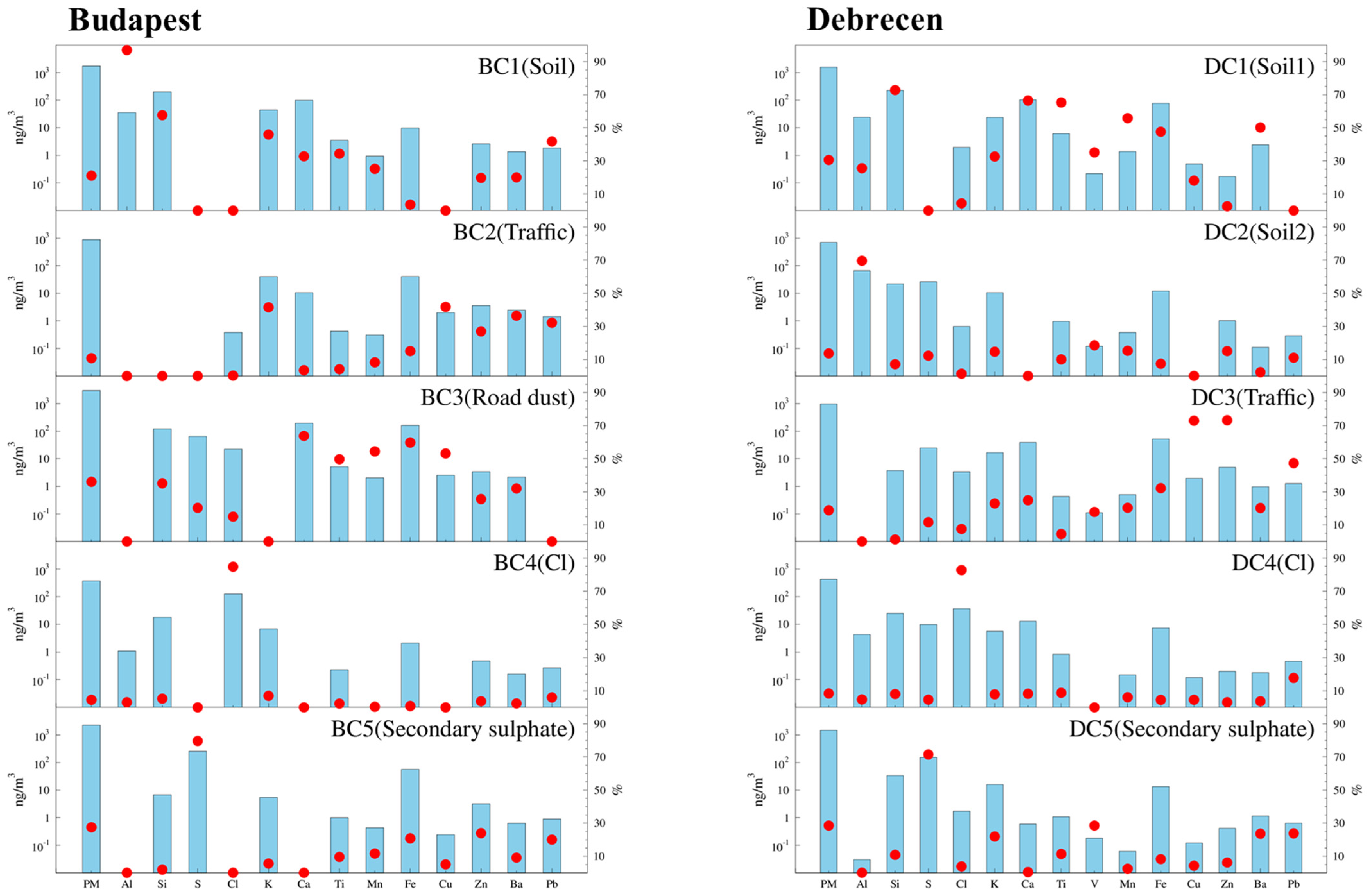
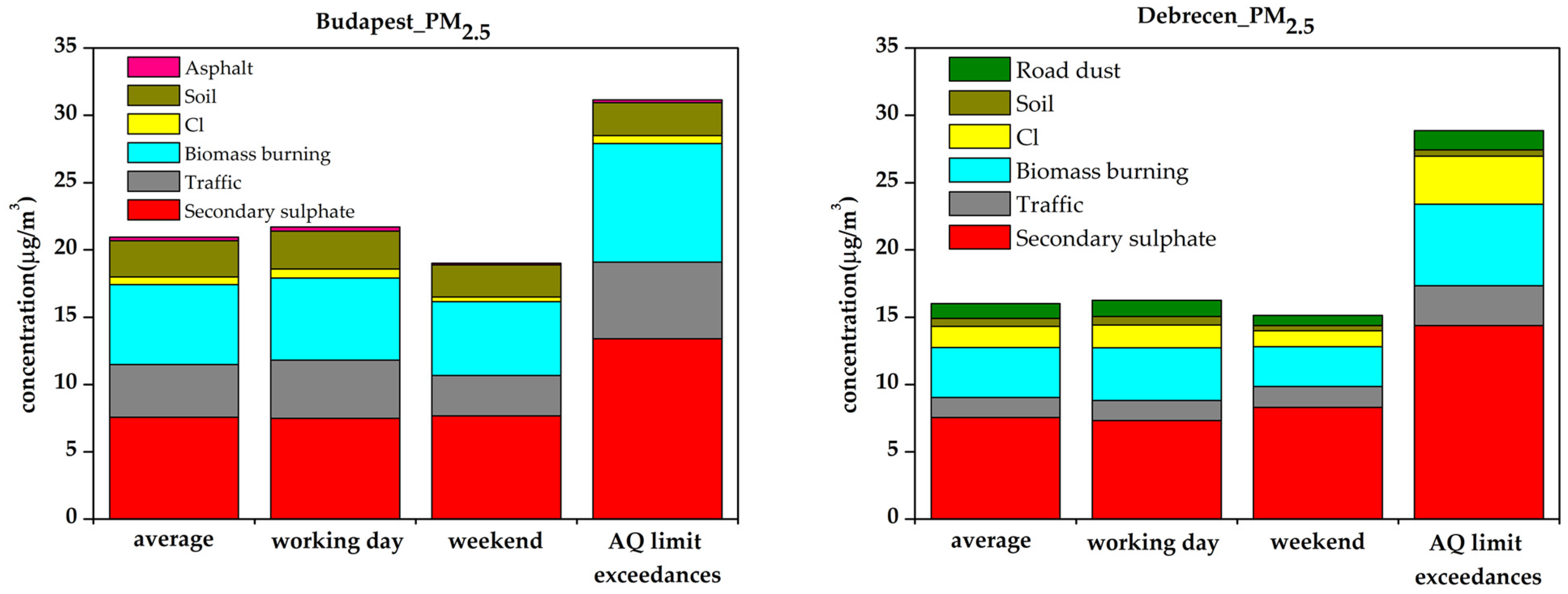

| Budapest (µg/m3) | Debrecen (µg/m3) | ||||||||
|---|---|---|---|---|---|---|---|---|---|
| PM2.5 | PMcoarse | PM10 | PM2.5/PM10 | PM2.5 | PMcoarse | PM10 | PM2.5/PM10 | ||
| December | Average | 17 | 8 | 24 | 0.67 | 16 | 5 | 21 | 0.73 |
| Median | 17 | 6 | 23 | 0.71 | 12 | 4 | 17 | 0.76 | |
| Min | 5 | 3 | 9 | 1 | 1 | 4 | |||
| Max | 34 | 21 | 43 | 56 | 14 | 67 | |||
| SD | 8 | 5 | 9 | 13 | 3 | 15 | |||
| January | Average | 24 | 10 | 34 | 0.74 | 19 | 5 | 24 | 0.78 |
| Median | 23 | 6 | 32 | 0.77 | 18 | 4 | 22 | 0.8 | |
| Min | 7 | 2 | 10 | 8 | 1 | 9 | |||
| Max | 43 | 58 | 89 | 36 | 13 | 47 | |||
| SD | 10 | 12 | 19 | 8 | 3 | 10 | |||
| February | Average | 25 | 8 | 32 | 0.73 | 20 | 5 | 25 | 0.78 |
| Median | 25 | 7 | 31 | 0.78 | 21 | 5 | 25 | 0.81 | |
| Min | 2 | 2 | 8 | 8 | 3 | 12 | |||
| Max | 59 | 18 | 68 | 40 | 11 | 48 | |||
| SD | 14 | 3 | 16 | 9 | 2 | 10 | |||
| March | Average | 15 | 10 | 25 | 0.6 | 11 | 6 | 16 | 0.65 |
| Median | 17 | 9 | 25 | 0.59 | 10 | 5 | 17 | 0.64 | |
| Min | 4 | 3 | 13 | 7 | 2 | 12 | |||
| Max | 26 | 17 | 40 | 16 | 12 | 23 | |||
| SD | 7 | 4 | 9 | 3 | 3 | 3 | |||
| Whole period | Average | 21 | 9 | 30 | 0.7 | 17 | 5 | 23 | 0.75 |
| Median | 20 | 7 | 28 | 0.74 | 15 | 4 | 19 | 0.78 | |
| Min | 2 | 2 | 8 | 1 | 3 | 4 | |||
| Max | 59 | 58 | 89 | 56 | 14 | 67 | |||
| SD | 11 | 8 | 15 | 10 | 3 | 11 | |||
| Budapest | Debrecen | |||||||||
|---|---|---|---|---|---|---|---|---|---|---|
| Average | Median | Min | Max | SD | Average | Median | Min | Max | SD | |
| Al | 68 | 59 | <DL | 272 | 56 | 17 | 4 | <DL | 109 | 25 |
| Si | 83 | 68 | 3 | 275 | 64 | 67 | 37 | <DL | 415 | 74 |
| S | 1201 | 1112 | 52 | 3194 | 752 | 1061 | 942 | 121 | 3271 | 658 |
| Cl | 15 | 8 | <DL | 108 | 20 | 5.6 | 1.5 | <DL | 52 | 9 |
| K | 311 | 299 | 26 | 758 | 155 | 294 | 255 | 26 | 1070 | 161 |
| Ca | 49 | 35 | 1 | 216 | 48 | 33 | 23 | 3 | 168 | 30 |
| Ti | 2.3 | 2 | <DL | 8 | 2 | 3.1 | 2.6 | <DL | 12 | 2 |
| Mn | 2.5 | 2 | <DL | 8 | 2 | 1.4 | 1.3 | <DL | 8 | 1 |
| Fe | 94 | 85 | 5 | 243 | 54 | 64 | 58 | 6 | 181 | 38 |
| Cu | 4.5 | 3.3 | <DL | 42 | 5 | 2.3 | 2 | <DL | 8 | 1 |
| Zn | 37 | 33 | <DL | 92 | 20 | 20 | 16 | <DL | 90 | 15 |
| Ba | 3 | 2 | <DL | 27 | 3 | 2.8 | 1.1 | <DL | 16 | 3 |
| Pb | 20 | 17 | <DL | 60 | 13 | 11 | 8 | <DL | 48 | 8 |
| BC | 3159 | 2972 | 317 | 6580 | 1376 | 1991 | 1759 | 389 | 6453 | 1048 |
| PM | 21,200 | 20,100 | 2420 | 58,800 | 11,300 | 17,400 | 15,200 | 1390 | 55,800 | 9530 |
| min. dust | 513 | 439 | 61 | 1529 | 339 | 319 | 231 | 26 | 1515 | 277 |
| Budapest | Debrecen | ||||||||
|---|---|---|---|---|---|---|---|---|---|
| Average | Median | Min | Max | SD | Average | Median | Min | Max | |
| Al | 65 | 28 | <DL | 420 | 88 | 94 | 71 | <DL | 604 |
| Si | 346 | 234 | 29 | 1121 | 291 | 311 | 211 | 6 | 1665 |
| S | 357 | 249 | 37 | 2623 | 425 | 218 | 186 | 41 | 693 |
| Cl | 177 | 46 | <DL | 2016 | 418 | 45 | 17 | <DL | 470 |
| K | 103 | 81 | 14 | 609 | 97 | 75 | 62 | 17 | 297 |
| Ca | 314 | 213 | 39 | 1070 | 265 | 164 | 112 | 7 | 1133 |
| Ti | 10 | 8 | 1.6 | 31 | 8 | 10 | 7 | <DL | 63 |
| Mn | 3.9 | 3.1 | <DL | 16 | 3 | 2.6 | 1.9 | <DL | 10 |
| Fe | 274 | 218 | 45 | 858 | 169 | 165 | 125 | 17 | 589 |
| Cu | 5 | 3.8 | <DL | 24 | 5 | 2.9 | 2.5 | 0.6 | 8 |
| Zn | 21 | 12 | 3 | 207 | 34 | 9 | 6 | 1.2 | 151 |
| Ba | 7 | 6 | <DL | 24 | 5 | 5 | 4 | <DL | 47 |
| Pb | 6 | 4 | <DL | 68 | 11 | 3 | 1.1 | <DL | 13 |
| PM | 8880 | 6720 | 1610 | 58,000 | 7900 | 5250 | 4470 | 1160 | 14,400 |
| min. dust | 1705 | 1208 | 229 | 5550 | 1284 | 1330 | 949 | 57 | 7223 |
| PM2.5 | PMcoarse | ||||
|---|---|---|---|---|---|
| r | p Value | r | p Value | ||
| PM | 0.58 | <0.01 | PM | 0.50 | <0.01 |
| BC | 0.30 | <0.01 | - | - | - |
| Si | 0.43 | <0.01 | Si | 0.62 | <0.01 |
| S | 0.66 | <0.01 | S | 0.53 | <0.01 |
| Cl | - | - | Cl | 0.50 | <0.01 |
| K | 0.45 | <0.01 | K | 0.53 | <0.01 |
| Ca | 0.46 | <0.01 | Ca | 0.53 | <0.01 |
| Ti | 0.36 | <0.01 | Ti | 0.63 | <0.01 |
| Mn | - | - | Mn | 0.53 | <0.01 |
| Fe | 0.27 | 0.01 | Fe | 0.46 | <0.01 |
| Cu | 0.27 | 0.05 | Cu | - | - |
| Zn | 0.35 | <0.01 | Zn | - | - |
| Pb | - | - | Pb | - | - |
Publisher’s Note: MDPI stays neutral with regard to jurisdictional claims in published maps and institutional affiliations. |
© 2022 by the authors. Licensee MDPI, Basel, Switzerland. This article is an open access article distributed under the terms and conditions of the Creative Commons Attribution (CC BY) license (https://creativecommons.org/licenses/by/4.0/).
Share and Cite
Furu, E.; Angyal, A.; Szoboszlai, Z.; Papp, E.; Török, Z.; Kertész, Z. Characterization of Aerosol Pollution in Two Hungarian Cities in Winter 2009–2010. Atmosphere 2022, 13, 554. https://doi.org/10.3390/atmos13040554
Furu E, Angyal A, Szoboszlai Z, Papp E, Török Z, Kertész Z. Characterization of Aerosol Pollution in Two Hungarian Cities in Winter 2009–2010. Atmosphere. 2022; 13(4):554. https://doi.org/10.3390/atmos13040554
Chicago/Turabian StyleFuru, Enikő, Anikó Angyal, Zoltán Szoboszlai, Enikő Papp, Zsófia Török, and Zsófia Kertész. 2022. "Characterization of Aerosol Pollution in Two Hungarian Cities in Winter 2009–2010" Atmosphere 13, no. 4: 554. https://doi.org/10.3390/atmos13040554
APA StyleFuru, E., Angyal, A., Szoboszlai, Z., Papp, E., Török, Z., & Kertész, Z. (2022). Characterization of Aerosol Pollution in Two Hungarian Cities in Winter 2009–2010. Atmosphere, 13(4), 554. https://doi.org/10.3390/atmos13040554






